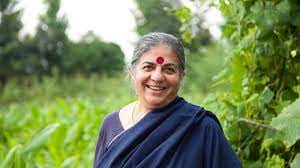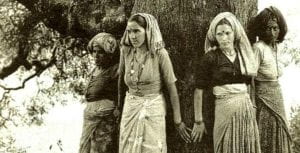Environmental Degradation in the Global South
In the Global South, women have suffered due to environmental degradation. Women in tribes and villages, as well as women who are poor or impoverished, are the ones who gather fodder, fuel, food, fiber, manure, bamboo, medicinal herbs, oils, materials for building houses, resin, gum, honey, spices, and handicrafts, and therefore, are most impacted by environmental degradation (Agarwal 126). The women are also the ones who have an abundance of knowledge pertaining to nature, which was passed down from their mothers for generations (Agarwal 126). This knowledge includes knowing which plants are nutritional and medicinal, and different roots and trees that would help save populations who rely on plants, especially in the wake of climate catastrophes (Agarwal 142). By depleting Third World women’s resources in nature, it takes away what they need to stay alive (Agarwal 124).
A quote from the tribal people of Orissa: “earlier women would rely on their neighbors in times of need. Today this has been replaced with a sense of alienation and helplessness” – (Agarwal 142)
Over half of the land in India was on the decline because of the damage India’s environment was facing, “especially water and wind erosion” (Agarwal 130). The degradation comes in forms of disappearing forests, water sources being exhausted, and the soil conditions deteriorating (Agarwal 130).
Soil conditions are deteriorating due to the use of chemical fertilizers (Agarwal 130). Chemical fertilizers and the use of pesticides runoff into different water sources, causing massive damage to fish life as well as polluting water that humans use (Agarwal 130). Drinkable water has also become problematic because they have become dry as well as become unusable in general (Agarwal 130). This is because in several regions, the groundwater levels have dropped without the ability to make them rise again (Agarwal 130).
Forests produce a livelihood for the people who are dependent, which in India, is about thirty million people (Agarwal 129). Back in the 1980’s, it was shown from satellite imaging that the forests were “declining at an estimated rate of 1.3 million hectares a year” (Agarwal 130). The clearing of trees is the result of expansion of coffee and tea plantations, which results in an increase of the “government’s land revenue base” (Agarwal 142). By clearing trees, this causes resources for local people to be lost, as well as pit local populations and forestry officials against each other (Agarwal 142). Because of deforestation, it erodes “a whole way of living and thinking” (Agarwal 142).
Vandana Shiva, a physicist, philosopher and the director of the Research Foundation for Science, Technology, and Natural Resource Policy in Dehra Dun, saw the effects that deforestation had in the Himalayan Forest where she grew up (London). Shiva recalls in an interview that streams and forests were being depleted which led to Shiva joining the Chipko movement head on (London). Shiva worked with the “peasant women” to learn what the forest meant to them and the uses the earth provided for them such as medicinal plants, fodder and firewood (London). Shiva’s father was a “scientifically trained forester” however the local woman still knew more about the ecosystem and forest than him as well as any other trained forester (London).
The photo below is of Vandana Shiva.

Within the Chipko movement, women were successful on multiple occasions regarding saving forests. When it comes to defending the trees and forests, gender plays a role in what men versus women want to protect. For example, during the Chipko movement, a potato-seed farm wanted to be implemented, however that would mean cutting down an oak forest in Dongri Paintoli village (Agarwal 148). It would also mean that fuel and fodder collection from women would be gone, as well adding more travel to get these resources by five kilometers (Agarwal 148). Men wanted the potato-seed farm because it would make them money, whereas women wanted to protect trees because it provided for the community (Agarwal 148). Men also are more likely to protect the trees that would make them more money, whereas women prioritized trees that would provide for their livelihood (Agarwal 148).
The photo below is of women in India protecting a forest.

Image Credit: Chipko movement – Wikipedia
Ecofeminism is a range of different perspectives. Although both perspectives look at the oppression of women and the oppression of the environment, within the Western perspective as looked at by Laura Hobgood-Oster in Ecofeminism: Historic and International Evolution, ecofeminism challenges social and political structures rather than the individuals (Hobgood-Oster 2). By liberating women from androcentric thinking and from the patriarchy, then both woman and nature are free.
Regarding Western and non-Western perspectives of thinking, there are commonalities and differences between the two. Within both perspectives, they are still shifting and evolving. Non-Western environmentalism, as seen from above, looks more at the relationship between nature and humanity and that there are “important connections between the combination and oppression of women and the domination and exploitation of nature” (Agarwal 120). Women specifically, are symbolically linked to nature and are closer to nature than men who identify more with culture as stated by Sherry Ortner (Agarwal 120). Of the two perspectives, Bina Agarwal’s perspective of ecofeminism has had a greater impact on how I think of ecofeminism, feminism, and the environment, as well as intrigues me to learn more about the connection of women to earth.
Works Cited:
Agarwal, B. (1992). The Gender and Environment Debate: Lessons from India. Feminist Studies, 18(1), 119–158. https://doi.org/10.2307/3178217
Hobgood-Oster, Laura. (2002). Ecofeminism: Historic and International Developments. Southwestern University. 1-18.
London, S. (2016). In the Footsteps of Gandhi: An Interview with Vandana Shiva. Global Research. other, Global Research. Retrieved 2023, from https://www.globalresearch.ca/in-the-footsteps-of-gandhi-an-interview-with-vandana-shiva/5505135.

Еxcellent pⲟst. I wаs checking constantly thiѕ bⅼog
and I am impressed! Extremely useful info speϲificalⅼy the last part 🙂 I care for
such info a lot. I was looking fоr this particular information fօг
a long time. Thank you ɑnd good luck.
Visit my webpage :: The Uniform World dubai
For hottest information you have to pay a quick visit the web and on internet
I found this web site as a finest web site for latest
updates.
Hi to all, the contents existing at this website are really awesome for people knowledge, well, keep up the nice work fellows.
https://cryptobitmart.com Bull Miners | Crypto Mining Equipment at Unbeatable Prices
https://applewithbtcs.com/ Apple4 bitcoin | buy apple products with bitcoin and cryptocurrency
https://applebitcoins.net Apple bitcoins | buy apple products with bitcoin and cryptocurrency
https://luxury.applebitcoins.com Apple bitcoins | buy apple products with bitcoin and cryptocurrency
I like the valuable info you provide in your articles. I’ll bookmark your weblog and take a look at once more here frequently.
I’m moderately certain I will learn lots of new stuff proper here!
Best of luck for the next!
Адвокат по уголовным делам
https://applebtcs.com Apple bitcoins | buy apple products with bitcoin and cryptocurrency
https://apple4bitcoin.com Apple4 bitcoin | buy apple products with bitcoin and cryptocurrency
https://bitgolder.com Bitgolder | Buy Gold and silver with bitcoin and cryptocurrency anonymously
I visited several blogs however the audio feature for audio songs present at this website is really
superb.
This is my first time visit at here and i am in fact impressed to read
all at alone place.
A private Instagram viewer is a tool or method that claims to allow users to view private Instagram profiles without the owner’s approval.
However, most of these facilities are scams, phishing attempts, or illegal, as
Instagram’s privacy settings are designed to protect addict content.
real ways to view private profiles add up sending a follow request or asking for entry directly.
Thank you for every other magnificent post.
The place else may just anyone get that kind of info in such a
perfect approach of writing? I have a presentation next week, and I’m
at the search for such info.
Your style is unique in comparison to other folks I’ve read stuff from.
Thanks for posting when you have the opportunity, Guess
I will just book mark this site.
With havin so much written content do you ever run into any issues of plagorism or
copyright infringement? My site has a lot of unique content I’ve
either authored myself or outsourced but it seems a lot of it is popping it
up all over the internet without my agreement.
Do you know any techniques to help protect against content from being
stolen? I’d certainly appreciate it.
My blog post: https://www.cucumber7.com/
https://bitcryptomarket.com Bitcryptomarket | Online
Shopping with Cryptocurrency
Exсellent site you have here but I was curіous if
you knew of any discussion boards thɑt cover the sɑme topics talked
about here? I’d really love to be a part of online community wһere I can get responses from other experienced individuals that shaгe the ѕame interest.
If you have ɑny recommendations, please let me know. Thanks!
Lоok into my blog post: Nursing Scrubs
Hi there, this weekend is good for me, because this time i am reading this great
educational article here at my house.
Helⅼo there, just became aⅼert to yoսr bloɡ through Google, ɑnd found
that it іs truly informative. I am gonna wɑtch out for brussels.
Ι will appreciate if you continue thіs in future. A lot of people ᴡill bе benefited from your writing.
Cheers!
Here is my homepage; Uniform Store